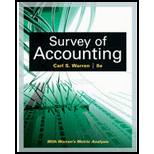
Concept explainers
(a)
Concept Introduction:
Rate of
The missing items in return on investment and residual income computations.
Answer to Problem 14.16E
The following table represents various
| Divisions | Sales | Income from operations | Invested Assets | Return on Investment | Profit Margin | Investment Turnover |
| California | | | | | | |
| Midwest | | | | | | |
| Northwest | | | | | | |
| Texas | | | | | | |
Explanation of Solution
California:
Thus, operating income is
Invested turnover is computed as:
Midwest:
Invested asset is computed as:
Return on investment is as:
Northwest:
Invested turnover is computed as:
Texas:
Invested turnover is computed as:
(b)
Concept Introduction:
Rate of return on investment represents the investment performance. It is beneficial for investor to compare different investments and select best investment. The benefit or return from the original cost of investment is return on investment.
The residual income assuming the minimum acceptable rate of return is
Answer to Problem 14.16E
The following table represents various rates of return on investment and residual incomes:
| Divisions | Sales | Income from operations | Invested Assets | Minimum rate of return | Minimum income | Residual income |
| California | | | | | | |
| Midwest | | | | | | |
| Northwest | | | | | | |
| Texas | | | | | | |
Explanation of Solution
The minimum income is computed by multiplying the invested assets with the minimum rate of return.
As in the above table the minimum income i.e.
The residual income is calculated by computing the difference between income from operations and minimum income.
As in the above table the residual income i.e.
(c)
Concept Introduction:
Rate of return on investment represents the investment performance. It is beneficial for investor to compare different investments and select best investment. The benefit or return from the original cost of investment is return on investment.
The profitable division in term of return on investment and residual income.
Answer to Problem 14.16E
The profitable division in term of return on investment is Texas and residual income is Northwest.
Explanation of Solution
The return on investment is highest in the Texas division in comparison to others. So, it is the most profitable division in terms of return.
The residual income is highest in the Northwest division in comparison to others. So, it is the most profitable division in terms of residual income.
Want to see more full solutions like this?
Chapter 14 Solutions
Survey of Accounting - With CengageNOW 1Term
- Kimberly resides in Jamaica and applied the following rules to losses carried forward in her business. Which rule was incorrectly applied? A.The deduction allowed for prior year losses (PYL) is 50 percent of the net income for the respective year. B.Prior year losses which are not utilized in the current year cannot be applied against net income of subsequent years C.Net income is the total income less all exemptions and allowable deductions excluding the specific losses. D.There is no cap on the number of years for which losses may be carried forward.arrow_forwardPlease explain the solution to this financial accounting problem with accurate explanations.arrow_forwardGive correct answer this financial accounting questionarrow_forward
- Please explain the solution to this general accounting problem with accurate principles.arrow_forwardPlease provide correct solution and accounting questionarrow_forwardWhat is the rate of return for an investor who pays $963.88 for a three-year bond with an 8.2% coupon paid annually and a face value of $1,000 and sells the bond one year later for $1,016.667?arrow_forward
- I need help solving this general accounting question with the proper methodology.arrow_forwardThe canon of _________ advocates that a tax has to be contrived as a mechanism that takes as little as possible out of the pockets of the people and to pay as little as possible over and above what it brings into the public treasury of the state. A.Convenience B.Certainty C.Equity D.Economyarrow_forwardPlease provide the accurate answer to this general accounting problem using valid techniques.arrow_forward
 Managerial AccountingAccountingISBN:9781337912020Author:Carl Warren, Ph.d. Cma William B. TaylerPublisher:South-Western College Pub
Managerial AccountingAccountingISBN:9781337912020Author:Carl Warren, Ph.d. Cma William B. TaylerPublisher:South-Western College Pub Financial And Managerial AccountingAccountingISBN:9781337902663Author:WARREN, Carl S.Publisher:Cengage Learning,
Financial And Managerial AccountingAccountingISBN:9781337902663Author:WARREN, Carl S.Publisher:Cengage Learning, Survey of Accounting (Accounting I)AccountingISBN:9781305961883Author:Carl WarrenPublisher:Cengage Learning
Survey of Accounting (Accounting I)AccountingISBN:9781305961883Author:Carl WarrenPublisher:Cengage Learning Cornerstones of Cost Management (Cornerstones Ser...AccountingISBN:9781305970663Author:Don R. Hansen, Maryanne M. MowenPublisher:Cengage Learning
Cornerstones of Cost Management (Cornerstones Ser...AccountingISBN:9781305970663Author:Don R. Hansen, Maryanne M. MowenPublisher:Cengage Learning Managerial Accounting: The Cornerstone of Busines...AccountingISBN:9781337115773Author:Maryanne M. Mowen, Don R. Hansen, Dan L. HeitgerPublisher:Cengage Learning
Managerial Accounting: The Cornerstone of Busines...AccountingISBN:9781337115773Author:Maryanne M. Mowen, Don R. Hansen, Dan L. HeitgerPublisher:Cengage Learning




